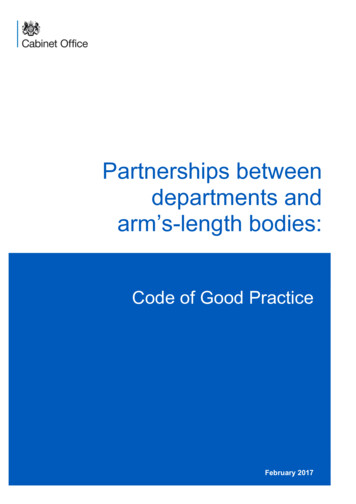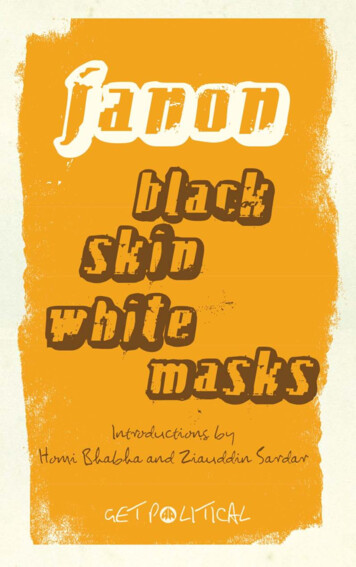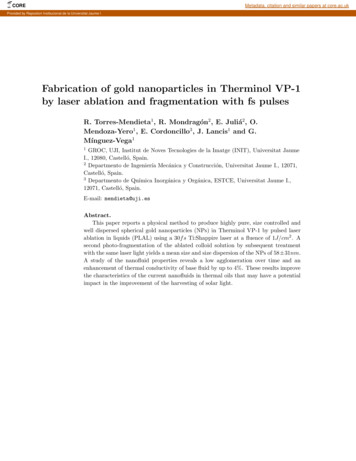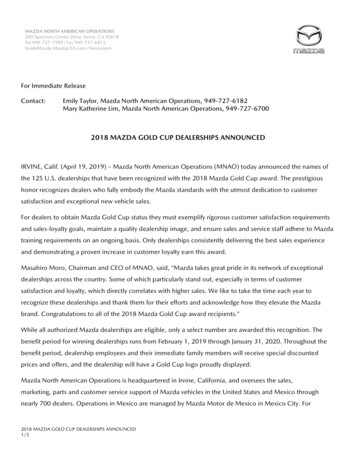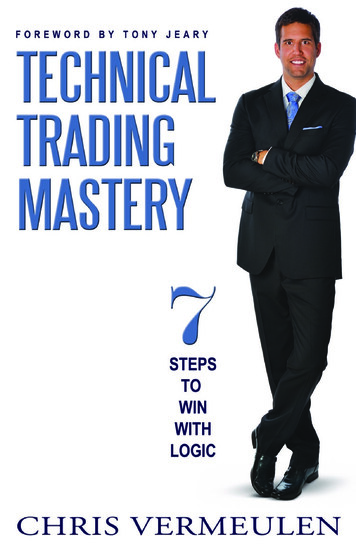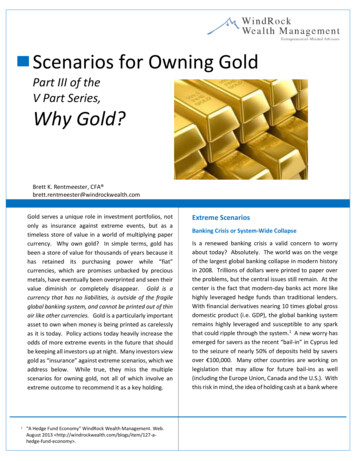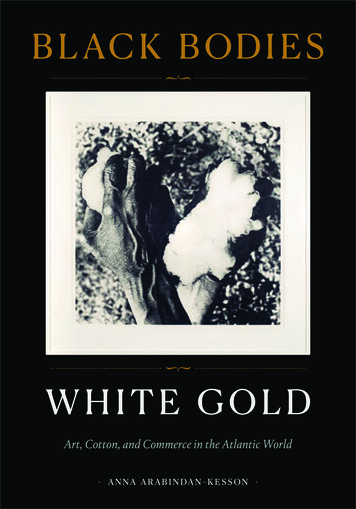
Transcription
Black BodiesWhite GoldArt, Cotton, and Commerce in the Atlantic World· Anna Arab indan - K esson ·
BLACK BODIES, WHITE GOLDArabindan ALL FF.indd 12/24/21 12:59 PM
BL ACKB O D I E S,WHITEGOLDArt, Cotton, and Commerce in the Atlantic WorldAnna Arabindan- KessonDuke University Press · Durham and London{Arabindan ALL FF.indd 32021}2/24/21 12:59 PM
2021 Duke University PressAll rights reservedPrinted in the United States of America on acid- free paper Project editor: Lisa LawleyDesigned by Matthew TauchTypeset in Portrait Text by Copperline Book ServicesLibrary of Congress Cataloging- in- Publication DataNames: Arabindan- Kesson, Anna, author.Title: Black bodies, white gold : art, cotton, and commerce in the Atlantic world /Anna Arabindan- Kesson.Description: Durham : Duke University Press, 2021. Includes bibliographicalreferences and index.Identifiers: lccn 2020030916 (print)lccn 2020030917 (ebook)isbn 9781478011927 (hardcover)isbn 9781478014065 (paperback)isbn 9781478021377 (ebook)Subjects: lcsh: Cotton in art. Slavery in art. Cotton trade—Atlantic OceanRegion—History—19th century. Slavery—Atlantic Ocean Region—History—19thcentury. Cotton growing—Atlantic Ocean Region—History—19th century. African diaspora in art. Atlantic Ocean Region—Commerce—History—19th century.Classification: lcc n8217.c64 a733 2021 (print) lcc n8217.c64 (ebook) ddc 704.0396—dc23lc record available at https://lccn.loc.gov/2020030916lc ebook record available at https://lccn.loc.gov/2020030917Cover art: Hank Willis Thomas, Black Hands, White Cotton, 2014.Screen print and Carborundum on paper, 87.6 87.3 cm. (34 1/2 34 3/8 in.) Hank Willis Thomas. Courtesy of the artist and Jack ShainmanGallery, New York.This publication has been made possible through supportfrom the Terra Foundation for American Art InternationalPublication Program of CAA.This publication is made possible in part with support fromthe Barr Ferree Foundation Fund for Publications, Department of Art and Archaeology, Princeton University.Arabindan ALL FF.indd 42/24/21 12:59 PM
For ThathaArabindan ALL FF.indd 52/24/21 12:59 PM
ContentsAcknowledgments ix· Illustrations xvIntroduction: Threads of Empire11 · Circuits of Cotton292 · Market Aesthetics: Color, Cloth, and Commerce673 · Of Vision and Value: Landscape and Labor after Slavery1214 · Material Histories and Speculative Conditions171Coda: A Material with Memory203Notes 213Arabindan ALL FF.indd 7· Bibliography 247·Index 2852/24/21 12:59 PM
AcknowledgmentsMy book tells a story about the formation of Blackness, primarily in theUnited States, and so, I am indebted to the Indigenous owners of the land onwhich the imperial project of the United States of America is being formed.As an immigrant settler I acknowledge that I live, write, research, and teachon unceded lands. In Princeton the land on which I live and work is part ofthe homeland and traditional territory of the Lenape people. I pay respect toLenape peoples — past, present, and future —and to their continuing presencein the homeland and throughout the Lenape diaspora. (I adapted this statement from Many Voices, One Future: An Inclusive Princeton [https://inclusive.princeton.edu/node/1531].)I was able to write this book because of the generosity, labor, and love ofothers. And this is what I want acknowledge here.My art historical journey started years ago when I studied nursing. Underthe guidance of lecturers at the Manukau Institute of Technology in Auckland I first learned how to observe and first understood how vision mediates the production of knowledge. It was as a nurse that I first grappled withcritical theories of race, decolonization, and feminism and began to makeconnections between community, individual experience, and structural conditions. This circuitous route to the academy gave me the grounding, andthe eyes, for what I now do.For their mentorship and teaching I thank my undergraduate professorsat the University of Western Australia, especially Clarissa Ball, Ethan Blue,and Rob Stewart. Their belief in me gave me the grounding to move forwardinto this field, and I could not do without their supportive friendship now.At Yale, where I completed my doctorate in African American Studies andthe History of Art, I was privileged to be advised by the dream team of professors Timothy Barringer and Hazel Carby. Not only did they put up withand allow me to work through my academic neurosis, they modeled an intellectual generosity, rigor, and empathy that will always inspire me. I amgrateful to call them friends.Arabindan ALL FF.indd 92/24/21 12:59 PM
Whatever we do, we do because of those who have come before us, andthe women who have paved the way in the field of Black diaspora art arefierce. Professor Deborah Willis is extraordinary. Thank you to ProfessorCeleste- Marie Bernier, Professor Kirsten Pai Buick, Professor Cheryl Finley, Professor Nikki A. Greene, Professor Kellie Jones, Dr. Courtney J. Martin, Professor Gwendolyn DuBois Shaw, and Professor Krista Thompson forwriting the books and navigating the conditions of academia in ways thatinspire and sustain others. The ongoing community of women I have gotten to know through the Women and Migration network — especially, butnot only, Professor Sama Alshaibi, Professor Tiffany Gill, Professor NeelikaJeyawardene, Sarah Khan, and Dr. Kalia Brooks- Nelson — continue to provide a space for profound care and care- full creativity. Thanks also to Professor Eddie Chambers, Professor Huey Copeland, Dr. Roshini Kempadoo,Professor Ian McLean, Professor Alan Rice, Professor Tanya Sheehan, Dr.Sarah Thomas, and Dr. Caroline Turner for their intellectual work, theirfriendship, and their generosity.Graduate school was an uncomfortable yet important experience. I waslucky to find myself in a well- resourced program that prepared me well to negotiate the dynamics of the academy. I will always be grateful to faculty, andformer faculty, in Yale’s African American Studies and Art History departments, in particular, professors Elizabeth Alexander, Ned Cooke, GlendaGilmore, Erica James, Kobena Mercer, Alondra Nelson, Alexander Nemerov,Sally Promey, Tamara Sears, and Robert Farris Thompson. Friends made atYale, including Sarah Haley, Key Jo Lee, Julia Lum, Shana Redmond, DavidStein, and Brandon Terry, continue to model what scholarship can do in theworld. I learned much from colleagues in Art History including MeredithGamer, Sylvia Houghteling, Nate Jones, Jennifer Nelson, Suzy Newbury(and the entire Newbury family), Sara Ryu, Alex Dika Seggerman, HollyShaffer, Richard Teverson, and Pan Wendt.To work somewhere that sustains, supports, and values you is an immenseprivilege. The Department of African American Studies and the Departmentof Art and Archaeology at Princeton University are such spaces. I am trulygrateful to all my colleagues, faculty, and administrators for their friendship, generosity, and brilliance. Their thoughtful comments on this projecthave made it stronger. Their collegiality and community show me that newfutures are possible. So too do my students. I am particularly thankful toCharmaine Branch, Tati Evans, Imani Ford, Mahishan Gnanaseharan, JackLeahey, Janette Lu, Jamal Maddox, Bhavani Srinivas, Sydnae Taylor, PhoebeWarren, and Jessica Womack: your optimism, passion, and extraordinary insights keep me going. I owe an immense amount of gratitude in particularA c k n ow l e d g m e n t s{x}Arabindan ALL FF.indd 102/24/21 12:59 PM
to Imani and Charmaine, for their excellent research assistance. I receivedgreat encouragement from other colleagues who read segments of the manuscript or heard me give talks based upon it. Thank you to Monica Huertaand Nijah Cunningham. Sincere thanks to Alicia Walker at Bryn Mawr College, Siona Wilson at the Graduate Center, cuny, David Peters Corbett atthe Courtauld Institute of Art, Tiffany Boyle at the Glasgow School of Art,and Petra Goedde at the Center for Humanities at Temple University. I amespecially grateful for their invitations to share my work, and for the generous feedback I received.My research work has been supported by several fellowships. I have benefitted from generous awards from the Gilder Lehrman Center for Studies inSlavery at Yale, the Yale Center for British Art, and the Whitney and BettyMacMillan Center for International and Area Studies at Yale. I was privileged to receive a Junior Research Fellowship from the Paul Mellon Centerfor Studies in British Art; a predoctoral fellowship from the Winterthur Library, Gardens, and Museum; and a Terra Foundation for American Art Predoctoral Fellowship at the Smithsonian American Art Museum. Research forthis book has been supported by a Robert W. Wark Fellowship at the Hunt ington Library and by both a Summer Research Award and a Vice- Provostfor the Arts Grant Award from Temple University. This book’s publicationhas been made possible in part with support from the Barr Ferree Foundation Fund for Publications, Department of Art and Archaeology, PrincetonUniversity and by a Terra Foundation Publication Grant.Throughout my research I have found the generosity of curators, archivists, and colleagues to be astounding. Thanks go to Clare Sheridan and Diane Fagan Affleck at the American Textile History Museum, who talked methrough the intricacies of cotton at the very beginning of this project. Dr.Linda Eaton at Winterthur patiently gave me a crash course in textile history while opening up the haptic world of cloth. Dr. Rosemary Crill at theVictoria and Albert Museum and Professor Chris Breward, Director of National Museums, Scotland, also gave me wonderful insights into textile studies and fashion history. At the British Museum, Jim Hamill and Helen Wolfewere very helpful in my quest for Manchester- made trade textiles. Curatorsand archivists at the Smithsonian — Dr. Joshua Bell, Dr. Pete Daniels, Dr.Nancy Davis, Craig Orr, Dr. Fath Davis Ruffins, and Dr. Bill Truetner — wereinvaluable in their encouragement and assistance as I navigated the arrayof materials available to study. Special thanks also to 2011 – 2012 saam pre- doctoral and senior fellows Professor Alan Braddock, Seth Feman, ProfessorPatricia A. Johnston, Erin Pauwels, Alex Taylor, and James M. Thomas forinsightful conversations and ongoing friendship.A c k n ow l e d g m e n t s{ xi }Arabindan ALL FF.indd 112/24/21 12:59 PM
Thank you to Adele Nelson ( Scott, Arthur, and Evelyn), who is familyas well as an always engaging and brilliant scholar. Similarly, Mia Bagnerisis a dream collaborator, dear friend, and sister. Esther Chadwick, thanks fora long friendship filled with tea, prosecco, optimism, beautiful music, andwarm welcomes. Zoe Whitley, my style guru, always reminds dour academics like me that our work must have meaning in the world. Thanks to NaomiSafron- Han for her fierce belief, and to Becky Conekin and Emily Orr for always being there. Horace Ballard brings all of us joy. Pam Franks and LisaHodermarsky gave me a home at Yale. I met Susan Hendricks and BarkleyL. Hendricks in December 2017 during graduate school, and they both remain close to my heart. Thanks to Petrina Dacres, Martina Droth, DaviniaGregory, Claudia Hucke, Rivke Jaffe, Nick Mead (Henry), Wayne Modest,and Tatsiana Zhurialova for getting us through the New Haven years, andfor their good counsel. To the extended Thomas- Brooks family: thank youfor taking us in, making us feel so welcomed and loved.This book was written between Australia, the United States, and theUK. This global village has provided me with so much care. These are thefriends who have helped raise my kids, who keep me grounded, who are holiday companions, the ones I laugh and cry with, the ones I have known fordecades. Thank you in abundance to Karen and John Alexander (Charlie,MJ, and Nomi), Larni and Jon Ashcroft (Amaya, Isumi), Holly Bass, ClareCorbauld (Alistair and Marcus), Tod Jones, Kate Croker (and Gabriel andOwen), Francis Flannagan and David Ritter (Josie and Rachel), Rick Haasand Grace Miller, Carrie and Jeff Hagen (Rae and Alec), Katy and Drew Leshko (Sage), Jo Lincolne, Cam and Ange Mackellar (Amalia and Noah), Richard McGlone and Tanya Gorowara- McGlone (Aaria), Janell and Ryan Olah(Camper and Maybelle), Sam and Justin Owen (Alec and Alys), Anat Plockerand Raz Segall (Ella), Scott and Cathy Ralph (Kael, Ava, Jero), and SarahStolfa and Mike (Madie and Lincoln).My family sustains me: My grandfather, Azariah Jesudas, a Tamil civil servant who experienced the British rule in Sri Lanka, impressed on all of us theimportance of reading critically. His ambivalence about the effects of colonization, the priority my family placed on education and debate, and ourexperiences of displacement and ethnic violence have shaped my relationship to, and critique of, everyday operations of power. In writing this bookI felt his presence often. I am so grateful to my parents, Sugi and Peter Kossen, who always encouraged me to explore widely and think critically. I hopemy father, Harry Kangadaren Arabindan, and my brother, Andrew JonathanArabindan — who left us years ago — would be happy to know I am doing thiswork. My beautiful sister Rebecca DeHaan is my forever inspiration; I aspireA c k n ow l e d g m e n t s{ xii }Arabindan ALL FF.indd 122/24/21 12:59 PM
to her grace, gentleness, and resolve. I am so grateful for our deep friendship.My brother- in- law Evan and my gorgeous niece and nephew, Esie and Josh,are great company. My brothers, Daniel and Tim Kossen, always make melaugh and drive me crazy in turns. I love you and I’m glad to be your big sister. Emma and Donald Kesson are the best of parents- in- love. Thank you foryour encouragement, for countless meals, for tea and cake. Thank you to allour families, including my brothers and sisters- in- law, Andrew and Ali Kesson (Daniel, Eleanor, Bea) and Joanna and Mark Drennan (Angus), for looking after our children while I completed this
Project editor: Lisa Lawley . Designed by Matthew Tauch. Typeset in Portrait Text by Copperline Book Services. Library of Congress Cataloging-in-Publication Data Names: Arabindan-Kesson, Anna, author. Title: Black bodies, white gold : art, cotton, and commerce in the Atlantic world / Anna Arabindan-
